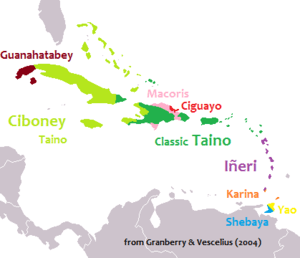Island Carib language
Island Carib, also known as Igneri (Iñeri, Inyeri, etc.), was an Arawakan language historically spoken by the Island Caribs of the Lesser Antilles in the Caribbean. Island Carib proper became extinct due to colonial genocidal activity by about 1920, but an offshoot survives as Garifuna, primarily in Central America.
| Island Carib | |
|---|---|
| Igneri | |
| Kalhíphona | |
| Native to | Windward Islands (Guadeloupe to Grenada, except Barbados) |
| Ethnicity | Island Caribs, Igneri |
| Extinct | 1920s in Dominica (survives in Garifuna) |
Arawakan
| |
Early form | Igneri
|
| Language codes | |
| ISO 639-3 | crb |
crb | |
| Glottolog | isla1278[1] |
 Iñeri (Island Carib) among other Pre-Columbian languages of the Antilles | |
Despite its name, Island Carib was not closely related to the Carib language of the mainland Caribs. Instead, it appears to have been a development of the Arawakan language spoken by the islands' earlier Igneri inhabitants, which incoming Caribs adopted in the pre-Columbian era. During the French colonial period, Carib men also spoke a Cariban-derived pidgin amongst themselves.
History
At the time of European contact, the Island Caribs lived throughout the Windward Islands of the Lesser Antilles, from Guadeloupe to Grenada. Contemporary traditions indicated the Caribs (or Kaliphuna) had conquered these islands from their previous inhabitants, the Igneri. Because the Island Caribs were thought to have descended from the mainland Caribs (Kalina) of South America, it was long assumed that they spoke Carib or a related Cariban language. However, studies in the 20th century determined that the language of the Antillean Caribs was not Cariban, but Arawakan, related Lokono and more distantly to the Taíno language of the Greater Antilles.[2]
Modern scholars have proposed several hypotheses accounting for the prevalence of an Arawak language among the Island Caribs. Scholars such as Irving Rouse suggested that Caribs from South America conquered the Igneri but did not displace them, and took on their language over time.[2] Others doubt there was an invasion at all. Sued Badillo proposed that Igneri living in the Lesser Antilles adopted the "Carib" identity due to their close economic and political ties with the rising mainland Carib polity in the 16th century.[3] In any event, the fact that the Island Caribs' language evidently derived from a pre-existing Arawakan variety has led some linguists to term it "Igneri". It appears to have been as distinct from Taíno as from mainland Arawak varieties.[2]
During the period of French colonization in the 17th century, and possibly earlier, male Island Caribs used a Cariban-based pidgin in addition to the Arawakan Island Carib language. The pidgin was evidently similar to one used by mainland Caribs to communicate with their Arawak neighbors. Berend J. Hoff and Douglas Taylor hypothesized that it dated to the time of the Carib expansion through the islands, and that males maintained it to emphasize their origins.[4] However, scholars who doubt the existence of a Carib invasion suggest this pidgin was a later development acquired by contact with the Caribs of the mainland.[3]
Island Carib was extinct by the 1920s, but an offshoot, Garifuna, is still spoken by the Garifuna people living mainly in Central America.
Phonology
This is a reconstruction based on previous evidence and present-day observations of the Garifuna made in 1955.[5]
References
- Hammarström, Harald; Forkel, Robert; Haspelmath, Martin, eds. (2017). "Island Carib". Glottolog 3.0. Jena, Germany: Max Planck Institute for the Science of Human History.
- Rouse, Irving (1992). The Tainos. Yale University Press. p. 21. ISBN 0300051816. Retrieved June 17, 2014.
Island Carib.
- Hill, Jonathan David; Santos-Granero, Fernando (2002). Comparative Arawakan Histories: Rethinking Language Family and Culture Area in Amazonia. University of Illinois Press. p. 54. ISBN 0252073843. Retrieved June 17, 2014.
- Rouse, Irving (1992). The Tainos. Yale University Press. pp. 21–22. ISBN 0300051816. Retrieved June 17, 2014.
Island Carib.
- Taylor, Douglas (1955). Phonemes of the Hopkins (British Honduras) Dialect of Island Carib. International Journal of American Linguistics: The University of Chicago Press.